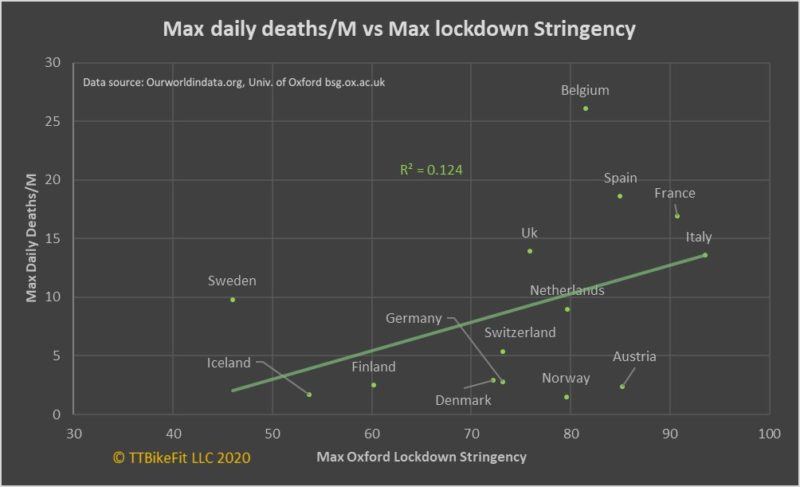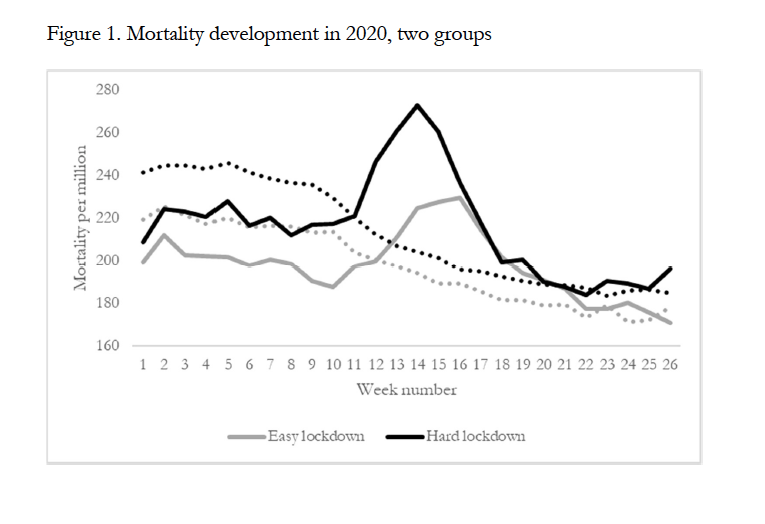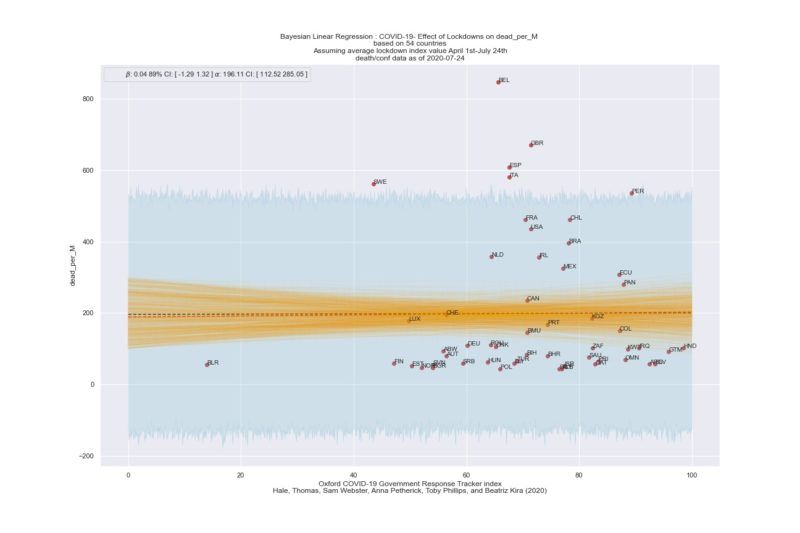The Virus Doesn’t Care about Your Policies

Based on the data, there seems to be no relationship between lockdowns and lives saved. That’s remarkable, given that we know for sure that lockdowns have destroyed economies the world over.
Every epidemic model being flung around in March built in the assumption that lockdowns would control the virus. In the early days, it was about preserving hospital capacity. Later it became a general principle: slow the spread. The methods were the same in nearly every country. Ban large gatherings. Close schools. Shutter businesses. Enforce stay-home orders. Mandate human separation. Masks. Travel restrictions.
Nothing like this has been tried in the whole history of humanity, certainly not on this scale. You might suppose, then, there was absolute certainty that there would be a causal relationship between lockdowns and the trajectory of the virus. Just as the FDA doesn’t approve a drug unless it is proven to be safe and effective, one might suppose the same would be true for a policy that shattered every routine and trampled human rights in the name of disease mitigation.
Surely! It turns out that this is not the case. It was pure speculation that lockdowns would suppress this virus, and that speculation was based on a hubristic presumption of the awesome power and intelligence of government managers.
For five months, governments all over the world have been freaking out, ordering people around to do this and that, passing mandate after mandate, and yet there is no evidence that any of it matters to the virus.
Already in mid-April questions arose. Prof Isaac Ben-Israel, head of the Security Studies program at Tel Aviv University and the chairman of the National Council for Research and Development, looked at the data around the world and concluded that the virus comes and goes after 70 days regardless of the policies deployed. He found no relationship at all between locking down and transmission and death.
Fast forward to mid-July. Data scientists investigated the experience from the spring. They too found no relationship between the virus and policy. Putting it very bluntly: “Rapid border closures, full lockdowns, and wide-spread testing were not associated with COVID-19 mortality per million people.”
That’s awesome to consider. Billions of lives fundamentally altered. Economies wrecked. Centuries-old traditions of liberty and law thrown out. Police states everywhere. And to what end? The data indicate it was all for naught. Apparently, you cannot control a virus with state policies. The virus just doesn’t seem to care.
One helpful tool you can use to observe this comes from OurWorldinData, which offers a stringency index of government policies based on data from Oxford University.
Let’s look at the index based on the countries in the world with the highest C-19 mortality rates. They are San Marino, Belgium, UK, Spain, Peru, Italy, Chile, USA, France, Brazil, Netherlands, and Mexico.
Here are all these countries on the stringency index.
Most of these governments imposed a quick lockdown at about the same time, followed by a gradual and scattered effort to liberalize. Sweden is the great outlier here, of course. They all had high mortality rates, with some higher and some lower than Sweden. Counterfactuals are impossible, of course, but already this chart raises questions about whether and to what extent policies had anything at all to do with preventing deaths.
Another way to look at this is to compare the top six countries with the highest mortality per millions with the six significant countries with the lowest mortality per million. Those low-mortality countries are: Uganda, Burundi, Mozambique, Tanzania, Rwanda and Sri Lanka. All these countries locked down.
Notice the absence of a relationship between death and locking down vs. staying open.
Now consider 12 countries with very similar deaths per million (50, plus or minus 10). You can observe a huge range of policies, and no apparent relationship between those policies and outcomes in terms of deaths.
Here is a global chart of deaths per million compared with lockdown severity. You can look at it all day but it shows absolutely nothing meaningful in terms of policy.
Plotting only European countries yields a slightly strange result, a pattern but the opposite of what we are supposed to see. Todd Kenyon used the Oxford data to produce the following alarming chart showing the tighter the lockdown, the higher the deaths per million. There might be many other explanations for this but, here again, we see nothing suggesting that lockdowns improved outcomes.

In “Did Lockdown Work? An Economist’s Cross-Country Comparison,” Christian Bjørnskov finds “no clear association between lockdown policies and mortality development,” while offering the following chart:

You can do the comparison within the United States, thanks to this excellent study by five economists. The results are the same: whether you lock down or stay open shows no predictable pattern in deaths. If lockdowns saved lives, the curve should slant downwards to the right. It doesn’t slant at all. It’s seemingly random.
Once again, it’s almost as if the virus doesn’t care.
Source: Wallethub
Now, you can take apart this data on grounds that it is too aggregated, that there are too many variables based on demographics (average age of death the world over is 82 with comorbidities, nearly half in nursing homes), and so on.
At some point, we are going to have to throw in the towel. Whether a country locks down or stays open has as much predictive power over deaths per million as whether it rains today is related to the color of my socks. Or whether hurricanes are controlled by literacy rates.
In other words, the claim that lockdowns control viruses is pseudoscience or magical thinking of a deeply dangerous sort; it wrecks economies and lives.
To be sure, there are plenty of studies claiming that lockdowns saved lives but the high-profile ones are model-based extrapolations that presume the existence of a relationship that the facts do not seem to back up. If there is a broad-based research study using real data that demonstrates something life-saving about destroying rights and liberties in the name of virus control, I’ve yet to see it. (A disagreeing reader sends me this paper, which you are free to read and consider.)
Meanwhile, we are overwhelmed with evidence that it was all pointlessly destructive. Liberty means the practice of health and wealth; lockdowns lead to exactly what D.A. Henderson predicted: catastrophe.
Addendum: the NBER has published a paper that attempts to discover some impact of government mandates on virus transmission and death. The authors find none.












